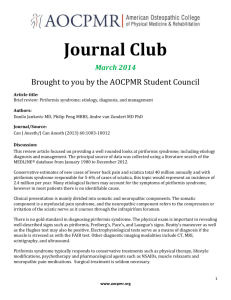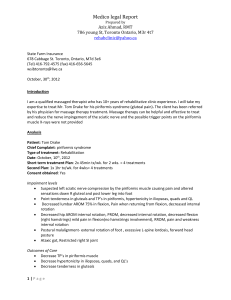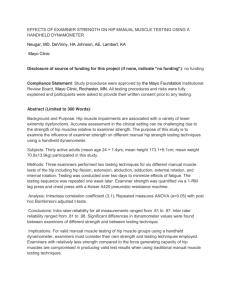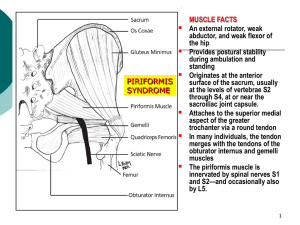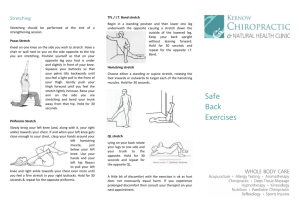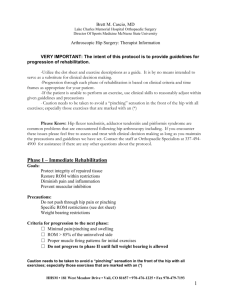August, 2012
advertisement
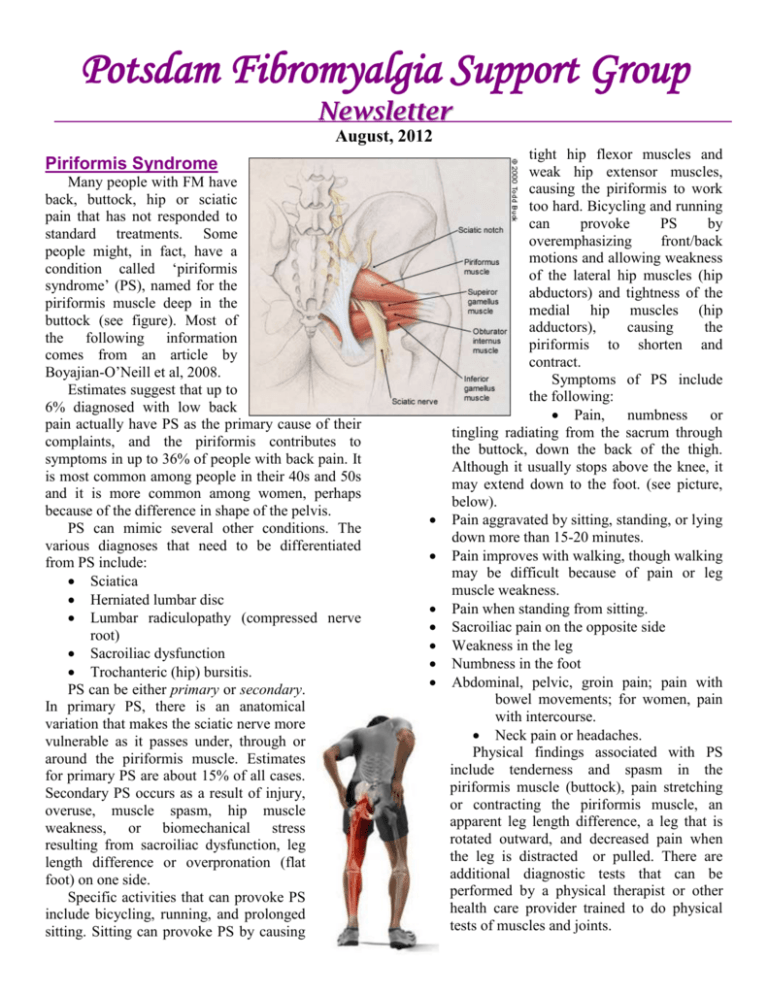
Potsdam Fibromyalgia Support Group Newsletter August, 2012 Piriformis Syndrome Many people with FM have back, buttock, hip or sciatic pain that has not responded to standard treatments. Some people might, in fact, have a condition called ‘piriformis syndrome’ (PS), named for the piriformis muscle deep in the buttock (see figure). Most of the following information comes from an article by Boyajian-O’Neill et al, 2008. Estimates suggest that up to 6% diagnosed with low back pain actually have PS as the primary cause of their complaints, and the piriformis contributes to symptoms in up to 36% of people with back pain. It is most common among people in their 40s and 50s and it is more common among women, perhaps because of the difference in shape of the pelvis. PS can mimic several other conditions. The various diagnoses that need to be differentiated from PS include: Sciatica Herniated lumbar disc Lumbar radiculopathy (compressed nerve root) Sacroiliac dysfunction Trochanteric (hip) bursitis. PS can be either primary or secondary. In primary PS, there is an anatomical variation that makes the sciatic nerve more vulnerable as it passes under, through or around the piriformis muscle. Estimates for primary PS are about 15% of all cases. Secondary PS occurs as a result of injury, overuse, muscle spasm, hip muscle weakness, or biomechanical stress resulting from sacroiliac dysfunction, leg length difference or overpronation (flat foot) on one side. Specific activities that can provoke PS include bicycling, running, and prolonged sitting. Sitting can provoke PS by causing tight hip flexor muscles and weak hip extensor muscles, causing the piriformis to work too hard. Bicycling and running can provoke PS by overemphasizing front/back motions and allowing weakness of the lateral hip muscles (hip abductors) and tightness of the medial hip muscles (hip adductors), causing the piriformis to shorten and contract. Symptoms of PS include the following: Pain, numbness or tingling radiating from the sacrum through the buttock, down the back of the thigh. Although it usually stops above the knee, it may extend down to the foot. (see picture, below). Pain aggravated by sitting, standing, or lying down more than 15-20 minutes. Pain improves with walking, though walking may be difficult because of pain or leg muscle weakness. Pain when standing from sitting. Sacroiliac pain on the opposite side Weakness in the leg Numbness in the foot Abdominal, pelvic, groin pain; pain with bowel movements; for women, pain with intercourse. Neck pain or headaches. Physical findings associated with PS include tenderness and spasm in the piriformis muscle (buttock), pain stretching or contracting the piriformis muscle, an apparent leg length difference, a leg that is rotated outward, and decreased pain when the leg is distracted or pulled. There are additional diagnostic tests that can be performed by a physical therapist or other health care provider trained to do physical tests of muscles and joints. As with most musculoskeletal conditions, the first step to treating it is figuring out what factors contribute to causing or perpetuating the problem. Treatments directly to the muscle will only provide temporary benefit unless the causes are addressed at the same time. Malalignment of the sacroiliac joint should be addressed through either manual therapy or specific exercises. A leg length difference or overpronation of the foot may require shoe orthotics. Medication can help some people; treatment generally starts with NSAIDs but may include muscle relaxants. Steroid or botox injections might be appropriate in some cases. Discuss these options with your health care provider. The following exercise guidelines are general suggestions for managing PS. You should discuss your personal situation and treatment with your health care provider. Other components of treatment can include massaging the muscle, either yourself or by a manual therapist (massage or physical therapist). There are additional ‘release’ techniques that manual therapists can use to get the piriformis to relax. You can perform trigger point release using a TheraCane or sitting on a lacrosse ball or ball made specifically for trigger point exercises. The picture (left) shows one of many ways to do pressure point release of the piriformis. In general, management should include stretching the piriformis and hip adductor muscles, as well as strengthening the hip abductors (gluteus medius), extensors (gluteus maximus) and external rotators (piriformis). Because many people have muscle weakness or tightness that currently prevents them from performing specific exercise movements accurately, it may be best to learn the strengthening exercises from a specialist such as a physical therapist. One example of a piriformis stretch is shown in the picture above, right, with the hip you want to stretch crossed over the other leg. Note that, due to a peculiarity of piriformis anatomy, it acts as an external rotator of the hip when it is extended or flexed up to about 60, but changes into an internal rotator past 90 of hip flexion; as a result, the stretch shown is done with the hip in external rotation. A Piriformis stretch: lean forward, hold 30-60 seconds Hip adductor muscle stretch: push stretch for the hip knees down, hold 30-60 seconds adductors is shown in the picture to the right, sitting with feet together and knees out to the side. Do not do any exercises that are painful unless specifically instructed by your health care provider. If you think you may have piriformis syndrome, discuss the possibility with your health care provider. Boyajian-O’Neill LA, et al. Diagnosis and management of piriformis syndrome: an osteopathic approach. J. Am. Osteopath. Assoc. 2008;108(11):657-664. August Potsdam Meeting: The August meeting of the Potsdam Fibromyalgia Support Group will be at 6:30 pm on Monday, August 27th. The topic is the same as last month’s meeting cancelled due to the storms: “A guided meditation with The Enchanted Garden, by Sheila Applegate. We will listen to the 30 minute meditation then discuss the role of reflection and meditation in managing chronic illness.” Those interested can get additional information about the Enchanted Garden CD at http://www.sheilaapplegate.com. Meetings are in Clarkson Hall, at 59 Main St. For information about meetings, contact CPH Physical Therapy Department at 261-5460. Massena Support Group: The Massena Support Group meets at 1:30 pm on the 2nd Saturday of each month in the Massena Hospital. For more information, please contact facilitator Maxine Dodge, at 769-5778. This newsletter is a joint effort of Clarkson University and Canton-Potsdam Hospital. If you would prefer to receive these newsletters electronically, please send your email address to gilberta@clarkson.edu. You can access current and previous Potsdam Fibromyalgia Support Group Newsletters on our web site: www.people.clarkson.edu/~lnrussek/FMSG.

